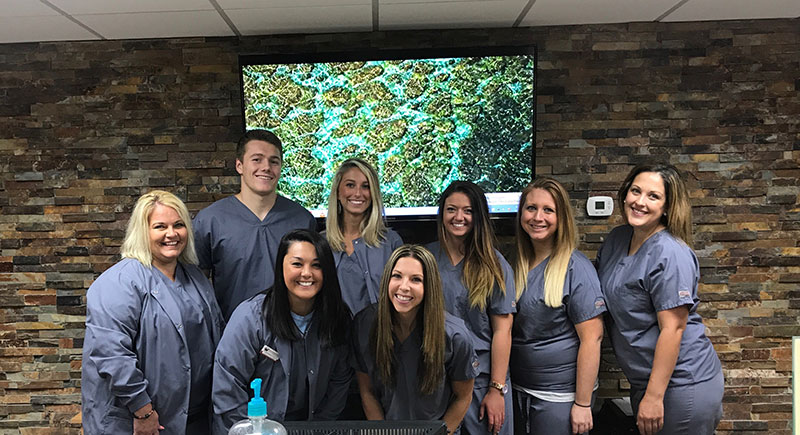Few states are in need of access to quality dental care as much as West Virginia. For two decades its flagship university has worked hard to help deliver it.
By Joshua Coe
WHEN DR. DON KINES graduated from West Virginia University’s School of Dentistry in 1990, he knew just where he wanted to practice: Davis, the minuscule West Virginia town near the Maryland border, in the area where he’d grown up. Fresh out of school, he landed a job as an associate with Davis’s only dentist— the only one, in fact, within 45 minutes in any direction.
Davis does have its draws: In the mid-1800s it was a lumber- and-mining entrepôt with a peak population of around 2,000 at the end of the nineteenth century, and today, as the Mountain State’s highest-altitude town, it’s popular with skiers and mountain bikers. Yet its year-round residents now number fewer than 700.
“It’s hard to attract dentists to a rural practice like this,” says Dr. Kines, 53. “You have to have the right person. If you have somebody who loves to ski, loves to golf, loves fishing, loves the outdoors, then you couldn’t ask for a better place.” He laughs. “If you’re looking for a larger city with lots of traffic lights, you’re not going to find it here.”
Rural communities throughout West Virginia face a similar challenge attracting qualified dentists. According to the federal Health Resources & Services Administration, as of December 2017 three out of four West Virginia residents live in “dental health professional shortage areas.”
For more than two decades, West Virginia University’s dental school—located in Morgantown, it’s the only one of its kind in the state—has risen to that challenge by sending its students on “rural rotations,” a graduation requirement during which they live and work for six weeks at one of 63 partnering clinics, private practices and community centers across the state.
Dr. Richard Meckstroth helped found the rural-rotation pro- gram, which debuted in 1997. Now chairman of WVU’s Department of Dental Practice and Rural Health, he says the goal is to persuade students to stay in-state after they graduate by exposing them to off-the-beaten-track spots badly in need of dentists. “It helps them understand that, yes, you can have a successful practice in a rural community and do very well—but at the same time you can make a real difference for the working poor,” he says.
Current student Elyse Reinher participated in the program last year and plans to open a practice in an untrammeled area once she’s out of school. “Working in rural West Virginia isn’t necessarily going to be the most glamorous job,” she says, “but if you’re in dentistry for the glamour, you’re welcome to move to Los Angeles. There are a lot of people here who need care.”
Indeed, the need is acute: 29 percent of West Virginians are on Medicaid, the highest rate in the country—but for adults, Medicaid dental coverage is limited to extractions. “It’s tough,” says Robert Waldrop, a current student supervised by Dr. Kines. “Especially when you know you have the ability to save these teeth, but the patient can afford only what their medical card allows—so you see a lot of patients in their twenties, thirties and forties already with complete dentures.” In the year to June 30, 2017, 58 WVU students performed more than 17,000 clinical procedures on nearly 9,000 patients at reduced rates. Students’ work annually amounts to about $6 million in uncompensated treatment. “We love it,” says Dr. Kines, who has hosted WVU students in his practice since the program’s first year. “I’m booked months ahead, so when students come in, I can get patients in right away and give them the discount. The patients ask me all the time when we’ll get another student.”
Although Waldrop plans to return to his native Pennsylvania after he graduates, he says he learned in particular the importance of balancing professionalism and compassion during his time with Dr. Kines—a lesson that will stick with him his entire career. “Patients just want functioning teeth,” he says. “You have to understand that it’s your career and you have to get paid for your services, but you also have to approach treatment in terms of finances and making sure your services are affordable.”
Waldrop remembers Dr. Kines once treating a patient who had recently been given a cancer diagnosis; he asked the patient to pay nothing more than the lab fee. “You go to church with these people,” Dr. Kines says when reminded of the story. “You see them at the grocery store, your children go to school with theirs, you see them at ballgames. I’ve seen children born in this community that I’ve worked on as they grow. I’ve seen some of my favorite patients pass away. We laugh together, we grieve together. Patients become your family, your friends.”
In its Oral Health Plan for the years 2016 to 2020, West Virginia’s Department of Health and Human Resources noted a looming problem: Although dental-workforce retention has improved recently, the state’s clinicians are aging; West Virginia expects 40 percent of its dentists to retire in the next decade.
Dr. Kines isn’t one of them—he’s personally more concerned about his own son’s plans. Although the younger Kines, 17, wants one day to attend WVU’s School of Dentistry, his father says he’s unsure if he’ll be able to keep his son in the fold. “When he was younger, he thought it would be fun to work with his dad,” Dr. Kines says. “Now I’m not so sure he thinks it’s such a good idea, because his dad can get kind of cranky.” With luck, the university’s rural outreach will be able to make up for the occasional tetchy father. West Virginia’s neediest are counting on it.





